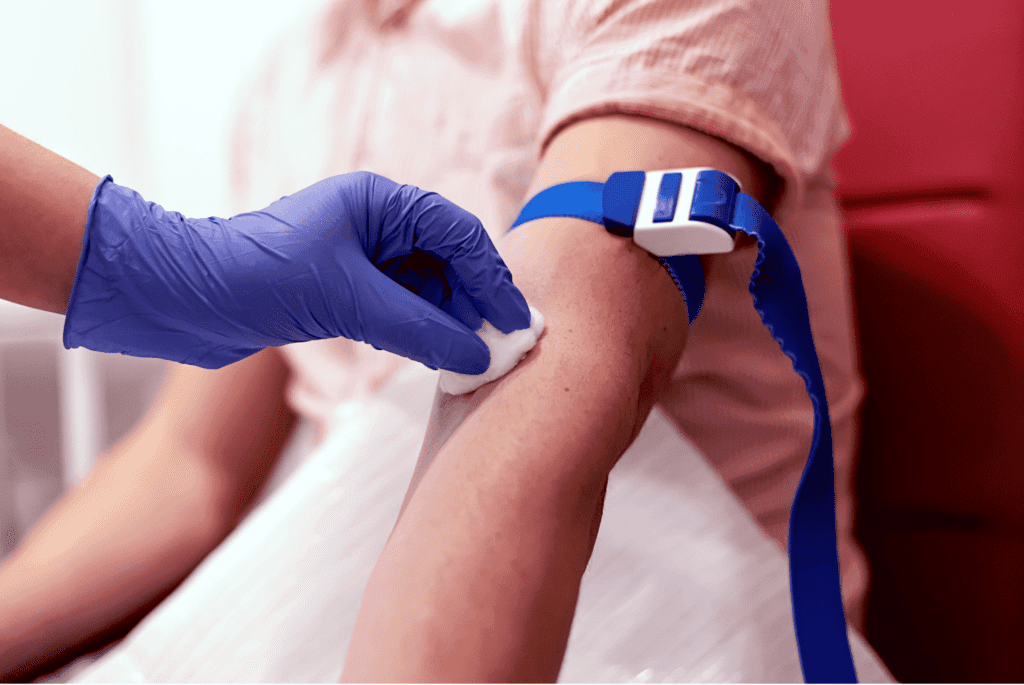Whether you’re needing to get your blood tested for medical reasons or you’re voluntarily donating blood, there may be a time in your life where you will need to get your blood drawn. A blood draw, otherwise known as a phlebotomy, is a very common medical procedure. A phlebotomy is the medical procedure of withdrawing blood from the circulatory system via a small puncture or incision in your vein. Getting blood work done is an important part of preventative healthcare.
In this article, we’ll explore what to expect from your next blood draw appointment.
Before the Blood Draw
Preparing for a blood draw procedure is crucial for setting yourself up for success. If you’re booked in for a blood draw appointment, it’s important to communicate with your doctor prior to the visit to ensure you’re following their specific instructions. Below are some general tips to consider prior to your blood draw.
- Hydrate! Be sure to drink plenty of water prior to your appointment. If you arrive dehydrated, your blood volume will be lower, making it harder and slower for your blood to be drawn. For a quick blood draw, make sure you’re coming to your appointment hydrated and ready to go.
- To prevent feeling light headed during the blood draw, be sure to eat a healthy meal prior to your appointment – unless specifically instructed to fast. A healthy meal consists of a source of protein, healthy fats, and carbohydrates. Check out these 5 healthy breakfast ideas that you can try before your blood draw appointment.
- Come with an exposed arm. To make the process easier, show up with a short sleeved shirt to make it easier for your medical practitioner to access your vein.
- Do not take aspirin two days prior to your blood draw appointment if you are donating platelets.
What to Expect During the Blood Draw Procedure
Depending on the type of blood draw you are getting done, the duration of the appointment will vary. For larger amounts of blood it can take up to 10-15 minutes, whereas small samples of blood will only take a few minutes.
How to Draw Blood
- Patient will expose the limb where the blood draw is occuring (usually non-dominant arm).
- A medical practitioner will lightly cut off circulation to the limb by tying an elastic band around the limb. By doing this, the veins become more apparent, making it easier for the phlebotomy.
- The medical practitioner will then sanitize the area with alcohol where small puncture will be made.
- Insert needle into the vein. The needle should be connected to a tube or syringe to collect blood samples.
- The medical practitioner will then release the elastic band and remove the needle. Patient will apply pressure to the area to stop bleeding.
- The medical practitioner will cover with bandage.
Keep Calm
Feeling nervous about your upcoming blood draw appointment is normal. Below are some helpful tips to help you stay calm whilst the blood draw is occurring.
- Keep breathing – deep breaths help to calm the nervous system.
- Listen to music.
- Look away – do not watch the needle insertion.
After the Blood Draw
Give yourself time to recover after a blood draw appointment. Do not expect to be able to continue your day as-per-usual. It’s very common for you to feel some side effects and it’s recommended that you give yourself some time to rest.
Below are some helpful tips you should consider following your blood draw appointment.
- Be prepared to have someone drive you home
- Keep bandage on the insertion site to minimize bleeding
- Take the day to rest and recover
- Apply ice to the area to minimize soreness
- Have a snack ready to go! Eating a hearty snack can help reduce lightheadedness
Side Effects
Some side effects are normal after a blood draw appointment. Most side effects are minor and will subside a few hours after the procedure.
- Bruising after blood draw. You may experience some small bruising around the area of the insertion. This is normal, and will heal within one to two weeks.
- Bleeding – keep a bandage on the site of insertion to minimize bleeding.
- Lightheadedness.
- Soreness – you may notice that your arm hurts after blood draw appointment
The Bottom Line
Getting blood drawn is a normal medical procedure that you will likely encounter in your life. With over 3,500 tests available, Your Health Lab offers many options and resources for monitoring your blood health. If you are needing blood tests, contact us today to book your appointment.
